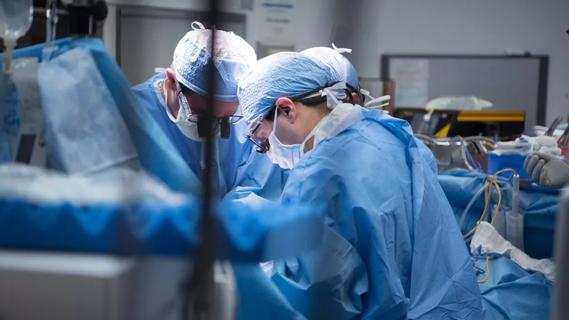A solution to the donor organ shortage

Debbie Kuntz knows that her daughter, Leta Saunders, was lucky to get a new liver so fast.
Cleveland Clinic is a non-profit academic medical center. Advertising on our site helps support our mission. We do not endorse non-Cleveland Clinic products or services. Policy
With the large number of patients on waiting lists for liver transplant and the relative scarcity of livers for donation, Debbie was surprised that 8-year-old Leta’s transplant was completed within a month of the family being told last autumn that Leta needed one. “It was really quick,” says Debbie, who lives with Leta in Fairport Harbor, Ohio.
The need was pressing because Leta, who was born with biliary atresia, developed refractory ascites and related infections about three months before her transplant. “We had to take her in to Cleveland Clinic Children’s every other week to have her abdomen drained of fluid — almost 3 liters’ worth each time,” says Debbie. “It really impacted her ability to play and kept her out of school a lot.”
Leta’s liver condition had been managed by pediatric hepatologist Vera Hupertz, MD, since Leta was about 1 year old. When the imminent need for transplant became clear, a quick match was possible because of the many options offered by Cleveland Clinic’s Pediatric Liver Transplant Program, including living-donor grafts as well as whole-organ and split-graft transplants from deceased donors.
In Leta’s case, a partial liver from an anonymous live donor was a good match, so the transplant team was able to perform the transplant less than a month after recommending it.
“A living donor made sense mostly from the standpoint of Leta’s size,” explains Dr. Hupertz, Medical Director of Pediatric Hepatology and Liver Transplantation. “Since she is a small girl, the pool of deceased donors available for her would have been limited. By having a living donor, she was able to take a smaller liver segment that was safe for an adult donor to contribute.”
Although this could also have been achieved with a split graft (when a deceased donor’s liver is divided into two parts so that two people can benefit from a single donation), it meant adding Leta to the organ waiting list to compete against other potential recipients. “With a planned donation from a healthy donor, Leta’s transplant could be scheduled and done relatively quickly,” Dr. Hupertz says. “Not many institutions are as aggressive as we are in using living-donor or split grafts, which is especially important in this era of organ shortages for pediatric patients.”
Leta was discharged from the hospital three weeks after the transplant, and her recovery at home “has been great,” her mom, Debbie, says. “She’s gained weight back, and her skin’s nice and peachy. Before she had a tint of yellow, including in the whites of her eyes. Now her eyes are white. She looks amazing.”
Leta was back at school part-time three months after her transplant, then went to school full-time. “She’s even better than her old self,” Debbie says. “I don’t remember her having this much energy before.”
Leta is one of many children who have received liver transplants here since Cleveland Clinic performed its first pediatric liver transplant in 1986. Between 2005 and 2013, the Pediatric Liver Transplant Program performed 45 liver transplants in patients 6 months to 19 years of age. More than half involved split livers from deceased donors or partial livers (left lateral segments) from living donors.
In addition to expert multidisciplinary medical care, pediatric patients receive care and counseling from a child psychologist, a social worker and child life specialists before and after transplant. The latter were especially helpful in Leta’s case. “Leta was very afraid she wouldn’t wake up after the transplant,” her mom says. “The child life specialists were very supportive and really made her feel better.”
The comprehensive approach to transplant care is a byproduct of Children’s Hospital’s broad transplant offerings and expertise.
“Ours is one of a small number of centers in the world where a child can receive any type of transplant, be it cellular, heart, liver, lung, kidney, pancreas, intestinal, composite tissue or multivisceral,” says Giovanni Piedimonte, MD, Physician-in-Chief and Chairman of Children’s Hospital & Pediatric Institute.
“With internationally celebrated surgeon and innovator Kareem Abu-Elmagd, MD, PhD, at the helm of Cleveland Clinic’s Transplant Center, we have begun performing multivisceral transplants to serve children whose critical needs would otherwise go unmet.”

Careful risk stratification is key

Findings support the safety of the technique

Insights from murine models could help guide care for patients

Reviewing how the drug can be incorporated into care

Insights on guiding treatment decisions

Largest, longest analysis to date shows greater weight loss and fewer diabetes medications needed

Strong patient communication can help clinicians choose the best treatment option

ctDNA should be incorporated into care to help stratify risk pre-operatively and for post-operative surveillance